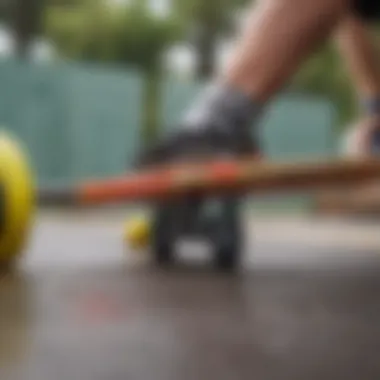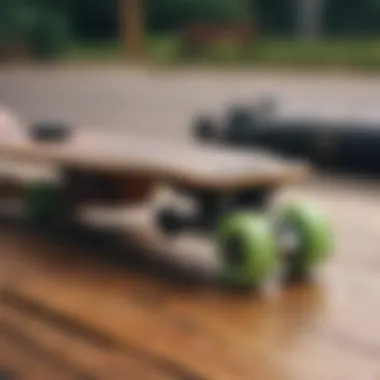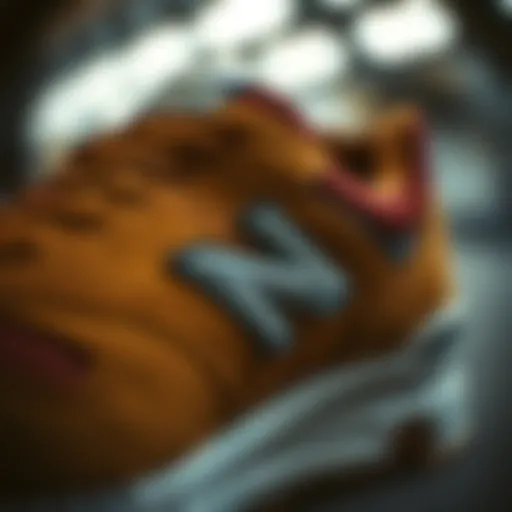Top Ten Longboards: An In-Depth Review and Guide


Intro
When it comes to longboarding, it’s more than just a ride; it’s a blend of balance, style, and skills that can sweep both newbies and seasoned riders off their feet. Longboards offer a way to cruise along streets or carve down hills, making them incredibly popular among skaters worldwide. But with so many options on the market today, it can feel like searching for a needle in a haystack.
This article dives headfirst into the world of longboards, exploring the top ten models you can currently find. Each of these longboards is assessed based on design, performance, and rider suitability. You'll find insights that cater to all kinds of users, from those who just want to glide around the block to those looking to perform tricks or hit high speeds.
We will also cover essential considerations when choosing a longboard, like the materials used, the types of wheels available, and how riding styles affect your choice. After all, riding the right longboard can make all the difference between a rewarding experience and a frustrating one.
This exploration is not just about models, though. We will discuss maintenance and care tips, giving you the inside scoop on how to keep your longboard in top shape for years to come. So whether you’re a skater, a coach, a parent, or an educator looking for detailed and insightful information, you’re in the right place. Let's break it down!
Understanding Longboards
Longboards have become increasingly popular among riders of varying skill levels. Understanding longboards is crucial as it serves as the foundation for making informed decisions about selection and use. Riders should appreciate not only the physical attributes of different boards but also how these factors influence their overall riding experience.
Definition and Purpose
A longboard is, in essence, a type of skateboard, but it typically features a longer deck and different design characteristics. Unlike traditional skateboards, longboards often offer greater stability and smoother rides, making them ideal for cruising, downhill racing, and even transportation. The length usually ranges from 33 inches to over 50 inches, allowing for variety in riding styles.
The primary purpose of a longboard is to provide a more comfortable and controlled ride, especially for those who focus on distance and speed. Riders often chase thrills down steep hills, carve smoothly around corners, or even use longboards for commuting in urban areas. Their elongated shape is not just about aesthetics—it plays a fundamental role in how riders maneuver and balance themselves. Ultimately, understanding this definition and purpose helps riders align their choices with their desired riding experiences.
Difference Between Longboards and Skateboards
When discussing longboards, it’s important to clarify how they differ from traditional skateboards. This distinction is not merely academic; it deeply impacts riding technique, enjoyment, and safety.
- Size and Shape: Longboards are longer, typically ranging from 33 to 60 inches, while skateboards generally measure between 28 and 32 inches. This extra length allows for a more stable ride.
- Wider Decks: Longboards often have wider decks as well which provides more space for foot placement, enhancing balance—especially beneficial for beginners.
- Wheel Sizes: Longboard wheels are usually larger and softer than skateboard wheels, offering more traction and a smoother ride over rough surfaces.
- Riding Style: Longboards excel in cruising, carving, and downhill riding, while skateboards are better suited for tricks and skateparks. With their design, longboards are less about flipping and more about gliding smoothly.
"Understanding these differences can significantly influence a rider's enjoyment and aptitude, allowing them to choose a board that best fits their style and needs."
In summary, the importance of understanding longboards encompasses recognition of their unique characteristics and uses. This sets riders up for success, whether they are looking to perform tricks, enjoy a leisurely ride, or navigate urban landscapes efficiently.
Factors to Consider When Choosing a Longboard
When stepping into the world of longboarding, one must tread thoughtfully. The choices are vast, and selecting the right longboard can utterly change your experience. This article dissects several important factors you should consider, ensuring that your longboard matches not just your needs but also your ambitions. Understanding these elements helps anyone, from casual riders to longboarding enthusiasts, make educated decisions.
Rider Skill Level
Every longboarder begins somewhere, whether you’re a novice just starting out or an experienced rider carving public spaces like a pro. The skill level significantly influences the type of longboard that suits you best. For beginners, options like the Penny Board or the Quest Super Cruiser can provide stability and ease of use. These boards tend to be wider and have a lower center of gravity, which can boost confidence in the early stages.
On the other hand, advanced riders might gravitate towards boards like the Land Yachtz Longboard for more technical maneuvers. They require a deeper understanding of balance and control but reward skilled riders with agility and speed. Remember, choosing a board that suits your current skills is crucial; a board too advanced may frustrate, while one too basic might limit growth.
Purpose of Use
The "what" behind your choice often determines the "how" of your riding experience. Identifying the primary purpose of using a longboard helps narrow down your options significantly. Do you plan on commuting to work, or are you more interested in downhill racing? For cruising, boards like the Arbor Axis could be perfect. They offer a smooth ride, enabling the joy of gliding through parks or city streets.
If speed is your game, however, you might want a more aerodynamic board, such as a drop-through longboard, tailored for downhill racing. Each of these categories has distinct characteristics that will affect your experience. Ideally, you want a board that compliments your style and intended use to enhance enjoyment.
Board Length and Width
The dimensions of a longboard also play a vital role in its performance and suitability. Longboards typically range from 28 to 50 inches in length, with a variety of widths available. A longer board generally provides more stability, making it an excellent choice for beginners or those looking for a stable ride. Conversely, shorter boards promote maneuverability, making them great for tricks or more technical riding.
Additionally, width affects foot positioning and overall comfort. Wider boards can give you a stable standing platform, while narrower boards may fit better in crowded spaces or for performing tricks. In general, assess your size and riding preference to find the right balance.
Materials and Construction
Last but not least, the materials and construction of a longboard are crucial for both durability and performance. Traditional wooden decks, often made from maple or bamboo, offer a classic aesthetic along with good flex and pop. However, materials like fiberglass or carbon fiber are becoming more popular for their lightweight yet extremely strong qualities.
Here are a few points to keep in mind:
- Wooden Decks: Friendly for beginners, can absorb vibrations.
- Fiberglass or Carbon Fiber: More expensive, but very stiff and responsive.
- Trucks and Wheels: Pay attention to these as well—they can alter the ride experience drastically.


Choosing a durable, well-constructed longboard can save you money and headaches in the long run.
Understanding these elements allows you to navigate the longboarding landscape with a clearer mind. Match your skill level, intended use, board dimensions, and materials carefully, and you're much more likely to find a longboard that you will love to ride.
Top Ten Longboards of the Year
The longboard scene has grown not just in numbers but in diversity, leading to a wide range of options tailored for various skating styles and preferences. In this section, we will explore the top ten longboards of the year 2023. These selections reflect a careful balance of performance, durability, and rider-friendliness. Knowing which longboard suits your needs is vital; whether you're cruising through a park or carving down a street, having the right board can totally change your experience.
When assessing these models, we consider several key factors including:
- Design and Aesthetics: A board's visual appeal can be just as important as its performance.
- Construction Quality: Materials used and how the board is made affect longevity and riding comfort.
- Ride Experience: Each model varies in responsiveness, speed, and stability, impacting how it feels to ride.
- User Reviews and Ratings: Insights from fellow riders offer a practical perspective on the boards' real-world performance.
- Price Point: We also weigh cost against features, ensuring good value for skaters of all budgets.
While opinions may differ, our choices have been backed by thorough analysis and community feedback, aiming to help every skater find the perfect match.
Model One: Overview and Specifications
Model One is known for its versatility and adaptability. With a length of 42 inches and a width of 9 inches, it's perfect for both beginners and seasoned riders. The board is made from a bamboo and maple blend, providing a light yet durable build. Riders appreciate its smooth ride and stability at high speeds, along with its aesthetic appeal featuring vibrant graphics.
Model Two: Overview and Specifications
Model Two stands out with its drop-through design, which lowers the rider's center of gravity and enhances stability. This board measures 40 inches long and 10 inches wide, making it suitable for cruising and downhill rides. Its sturdy construction of Canadian maple ensures longevity, while the soft wheels absorb shocks efficiently on rough surfaces.
Model Three: Overview and Specifications
For those seeking a lightweight option, Model Three weighs in at only 6 pounds. This board is crafted from bamboo and fiberglass, which not only makes it lightweight but also responsive. At 39 inches in length and 8.5 inches wide, it's built for agility and maneuverability, ideal for trick enthusiasts.
Model Four: Overview and Specifications
Model Four is celebrated for its deck shape that allows for a variety of riding styles. It's a 41-inch board that features a symmetric design, providing excellent control whether you're riding switch or regular. The high-density foam padding under the grip tape ensures comfort, even on longer rides.
Model Five: Overview and Specifications
Traditionalists may find Model Five particularly appealing. It echoes classic longboard styles with a modern twist, measuring 44 inches in length. Made from high-quality hardwood, it supports both smooth cruising and more aggressive downhill riding. Riders often mention the nostalgic feel paired with contemporary performance.
Model Six: Overview and Specifications
If you're into speed, Model Six is the one to look into. With its sleek 39-inch build and aerodynamic design, it promises quick rides and fast maneuvers. Constructed with carbon fiber, it combines lightweight properties with robust stability. Its wheels are designed for grip, making it a formidable choice for downhill enthusiasts.
Model Seven: Overview and Specifications
Model Seven is all about customization. It comes with removable wheel bases and various wheel options, appealing to those who want personalized setups. At 40 inches long, it’s versatile enough for beginners yet functional for experienced riders wanting different combinations for various terrains.
Model Eight: Overview and Specifications
For an eco-conscious choice, Model Eight uses sustainable materials without compromising on performance. This 42-inch longboard is made entirely from recycled plastics and bamboo composites. Riders love its impressively smooth ride on any surface, coupled with a design that makes it stand out aesthetically.
Model Nine: Overview and Specifications
A favorite among commuters, Model Nine features a compact design at 38 inches, making it easy to carry around. It is light yet sturdy thanks to its aluminum and wood combination. Users rave about its reliable performance in urban settings, where agility and durability are key.
Model Ten: Overview and Specifications
Lastly, Model Ten prides itself on premium features, including dual-layer construction and advanced wheel technology. At 41 inches, it offers excellent performance for cruising, tricks, and downhill riding. Many riders have noted its superb handling and grip, making it a top contender among performance boards.
Choosing from these models involves thinking about your personal style and preferred riding experience. Make sure to test as much as you can; often the right longboard feels just right under your feet.
Comparison of Features Among the Top Longboards
When venture into the longboard market, it becomes quite clear that not all boards are created equal. The comparison of features among the top longboards is essential, as it shines a light on the distinct characteristics that set each model apart from the others. Understanding these differences helps skaters, be they beginners or seasoned riders, make informed choices that align with their riding style and preferences.


Evaluating features is not just about aesthetics; it encompasses performance aspects, safety considerations, and durability. Riders need to weigh elements such as the type of wheels and trucks, the material used in construction, and the overall design. All these aspects play a significant role when it comes to a board’s responsiveness, stability, and longevity.
Performance Metrics
In the realm of longboarding, performance metrics are the backbone of any comprehensive comparison. Different riders feel comfortable with varying degrees of speed, ride smoothness, and agility.
- Speed: The material of the wheels, coupled with the board's overall structure, influences how fast a rider can go. High-durometer wheels, for instance, provide a faster, slick ride on smooth surfaces, while softer wheels offer more grip for rough terrains.
- Stability: A longboard with a low center of gravity and wide trucks typically performs better at higher speeds. Riders interested in downhill sessions may seek boards with wider stances, while those looking for tricks are likely to choose more agile boards.
- Maneuverability: This pertains to how easily a board turns and carves. It is greatly affected by the wheelbase length. A shorter wheelbase can create a sharp turning experience, favored in urban settings.
In summary, performance metrics inform a skater's experience on the board. Lack of awareness can lead to discomfort or unsafe riding conditions, while knowledge enables a tailored approach to riding.
"Understanding your board’s performance capabilities can elevate your overall skateboarding experience."
Durability and Maintenance
Investing in a longboard is similar to buying a trusty companion; you want it to last through many adventures. Therefore, durability and maintenance are crucial in the comparison of longboards. Different materials can impact how often a rider needs to replace or repair their board.
When discussing durability, resin-infused maple wood tends to hold up better against stress compared to softer woods. Fiberglass decks, on the other hand, are lighter and often provide enhanced flexibility. Riders should consider the deck’s construction when searching for longevity.
Maintenance is often overlooked, yet it can drastically extend the life of a longboard. Regular cleaning of wheels and bearings helps in keeping performance high. Noticing any unusual sounds or feel can go a long way in preventing bigger issues down the line. Skaters should also routinely check for any cracks, splintering, or other signs of wear.
To sum up, durability ensures an investment stands the test of time, and understanding maintenance routines leads to a smoother, more enjoyable riding experience. Lastly, a well-cared-for longboard not only performs better but can even become a cherished part of a rider's daily life.
Maintenance and Care for Longboards
When it comes to getting the most out of your longboarding experience, maintenance and care shouldn't take a backseat. Just like a trusty steed needs grooming, your longboard deserves some love to ride smoothly over the pavement. Keeping things in tip-top shape allows you to prolong the life of your board, maintain high performance, and ensure that every ride is a delight rather than a chore. While it may be tempting to throw your board in the corner after a session, knowing how to look after it can save you headaches and, importantly, money down the road.
The key elements of maintenance include regular cleaning to keep dirt and grime at bay and specific care for the wheels and bearings, which are critical to a smooth ride. Understanding this will not only enhance your overall experience but also perhaps even improve your tricks and control as you carve through the streets.
Regular Cleaning
Keeping your longboard clean is akin to keeping your car washed; no one want to drive a beat-up vehicle, right? Dust, dirt, and other debris can accumulate on your board’s surface and affect not only its appearance but also functionality. Regular cleaning contributes to a better grip on the wheels and a smoother ride overall.
Here are some steps to ensure your board stays clean:
- Wipe Down the Deck: Use a damp cloth or sponge to wipe the top and bottom of the deck. This removes dirt and any sticky residues that may have found their way onto the board.
- Consider the Grip Tape: A dirty grip tape can compromise your footing. Utilize a stiff brush or grip cleaner to scrub away any built-up grime. You’d be surprised at how much better you can ride with clean grip tape.
- Inspect for Damage: While cleaning, take a moment to check for any cracks, chips, or signs of wear and tear. Early detection of issues can be the difference between a simple fix and a complete board replacement.
Regular cleaning takes just a few minutes but can dramatically maintain your board's longevity. Remember, a clean board is a happy board!
Wheel and Bearing Maintenance
Next up is the heart of the ride: the wheels and bearings. They do the heavy lifting, absorbing shocks and providing the necessary speed and control. However, a lack of care can lead to a bumpy experience that may send you rolling in directions you didn't intend.
To keep things rolling smoothly, consider the following maintenance practices:
- Inspect the Wheels: Check for any flat spots or wear. These can affect your balance and overall ride. If they’re looking worse for wear, it might be time to invest in a new set.
- Cleaning the Wheels: Wipe the wheels down with a damp cloth. You might even consider removing them for a deeper clean. A brush can get into those hard-to-reach spots and ensure they’re free of debris.
- Bearing Care: Bearings need a bit of tender loving care. Over time, dirt can build up inside them, making them less effective. Remove them occasionally and clean using a bearing cleaner or a simple solution of rubbing alcohol. Just remember to dry them thoroughly afterward.
- Lubrication: After cleaning, apply a light lubricant to the bearings to keep everything moving freely. Don’t go overboard; a little goes a long way.
The maintenance of your wheels and bearings plays a significant role in ensuring that your longboard performs optimally. Remember, no one likes riding a clunky board. Regular attention can mean the difference between a subpar and a stellar ride.
Key Insight: Making maintenance a routine part of your longboarding experience not only enhances performance but can also lead to a safer and more enjoyable ride. Don't cut corners; care for your board as you would your best friend.
Community Insights and User Reviews
In any niche, community insights and user reviews can illuminate the path for newcomers and seasoned riders alike. When it comes to choosing a longboard, the experiences and feedback from other users add a layer of depth to the research process. Not only do these insights offer real-world perspectives, but they also help skateboarding enthusiasts make informed decisions based on practical use rather than just marketing hype.
Importance of User-Generated Content
User reviews serve as a window into the day-to-day functionality of each longboard. A rider’s personal story about how their board performed on a hill or during a cross-town cruise provides context that specifications alone cannot.
- Real-Life Usage: Unlike stark specifications, community feedback often reveals how boards behave under various riding conditions. For instance, a model might feel great on flat surfaces but falter on uneven terrain.
- Longevity Reports: Riders discuss how long their boards have lasted and whether the materials held up under regular use. This information is vital for potential buyers who are concerned about durability.
- Performance Insights: Users often highlight performance aspects such as stability, speed, or maneuverability that make them choose one board over another.


These insights also fuel the conversation around innovations, slowly pushing manufacturers to adapt and evolve their designs based on rider feedback.
Gathering Opinions from Experts
Expert Opinions
Reviewing expert opinions can be a game-changer when evaluating longboards. Professionals in the longboarding community often have experience across various boards, which allows them to offer nuanced critiques. Their assessments are generally grounded in technical knowledge, providing a balanced view compared to layperson reviews.
- Technical Insights: Experts can dissect a board’s construction and materials, often pointing out features that the average rider may overlook. For example, they might explain how a particular type of wood enhances flexibility and reduces weight, leading to a more enjoyable ride.
- Comparative Analysis: Seminars, blogs, and videos often feature comparisons between competing models. Experts frequently weigh the pros and cons of each option, which can simplify the decision-making process for those unsure about their choice.
- Safety Considerations: Professionals emphasize the importance of safety features, which can sometimes go unnoticed in user reviews. For instance, a longboard's grip tape quality or deck design can significantly influence stability.
Rider Experiences
Rider experiences add emotional and experiential layers to the overall narrative about longboards. Anecdotes and stories can resonate strongly with new riders, making the selection process more relatable.
- Personal Growth: Many riders share how they progressed in their skills using specific boards. Their experiences often capture the essence of not just riding, but developing a niche in the sport—be it cruising or tricks.
- Community Building: Beyond just reviews, riders often narrate how the boards built connections within their communities. Through shared experiences at skate parks, competitions, or group rides, users weave a collective tapestry around brands and models.
- Challenges Faced: Important revelations often come from riders discussing challenges faced while using a board. They may mention issues like wheel wear or deck wobble, which can inform newcomers about what specific problems to watch out for.
In summary, community insights and user reviews contribute invaluable perspectives that go beyond mere product details. By incorporating experiences from a diverse range of riders and expert critiques, this article aims to equip readers with a holistic understanding of the longboard landscape. By listening to others, you can steer clear of pitfalls and find a board that truly aligns with your riding style.
Future Trends in Longboarding
In the realm of longboarding, keeping an eye on future trends is crucial for enthusiasts and newcomers alike. Understanding what’s on the horizon allows riders to make informed decisions about their equipment, ensuring performance and sustainability go hand-in-hand. It’s not just a hobby; it’s a dynamic culture that continues to evolve with shifting technologies, lifestyle changes, and environmental considerations. As longboarding gains traction among diverse groups, the trends emerging now will shape the riding experience for years to come.
Innovations in Design
The design landscape of longboards is experiencing a refreshing evolution, thanks in large part to advancements in technology and rider feedback. Board makers are starting to think outside the box, creating shapes and styles that cater specifically to the varying needs of riders. For example, the use of different concave shapes provides varying levels of foot grip and control, helping riders feel more in tune with their board.
- Wider Decks: Wider decks are becoming increasingly popular, providing a stable platform that caters to all skill levels, from beginners to seasoned pros. This design tweak enhances balance, making tricks and cruising much safer.
- Enhanced Wheel Technology: Riders are now seeing wheels engineered for specific surfaces and riding styles. These wheels can now absorb shock better, offering a smoother ride on rough terrain.
- Lightweight Materials: Longboards made from lightweight composites offer improved maneuverability. Innovations like carbon fiber and bamboo contribute to stiffer boards that don’t compromise on weight.
Ultimately, these design innovations not only improve performance but also expand the longboarding experience. Skaters can now enjoy tailored solutions that fit their personal style, whether they’re commuting or carving down hills.
Sustainability in Materials
A significant shift is happening towards eco-friendly materials in longboarding. As awareness about environmental impact grows, manufacturers are incorporating sustainable practices into their production processes. This includes using woods sourced from responsibly managed forests, biodegradable plastics, and recycled materials.
- Bamboo: More brands are adopting bamboo for their decks. It’s renewable, lightweight, and strong. Furthermore, its natural flex provides a comfortable riding experience.
- Recycled Plastics: Some companies are even experimenting with using recycled plastics for wheels and components. This not only helps in reducing waste but also cuts down on the carbon footprint associated with traditional manufacturing.
- Eco-friendly Finishes: Low-VOC (volatile organic compound) finishes are gaining ground, offering riders a way to have beautiful boards that are less harmful to the environment during both production and usage.
A commitment to sustainability is not only beneficial for the planet, but it also resonates with the conscientious consumer. As these trends take hold, riders can enjoy their passion while contributing to a healthier environment, ensuring future generations have the opportunity to experience longboarding.
The future of longboarding is not just about riding; it’s about making choices that impact our world positively.
The End: Choosing the Right Longboard
Selecting the right longboard is a pivotal step that can significantly impact your skateboarding experience. Whether you’re a newbie just sampling the thrill of gliding down the street or a seasoned rider perfectly in tune with your board's nuances, making an informed choice is essential. Longboards are not just simple wooden planks with wheels attached; they have distinct characteristics that cater to various riding styles and purposes. The right board can enhance performance, boost confidence, and elevate overall enjoyment.
When it comes to pinpointing what defines the right longboard for you, a few key elements come into play. First, consider your skill level. Are you a rookie rider still finding your balance, or an experienced skater who craves speed and agility? Most boards are tailored for specific skill levels, so it’s wise to pick one that aligns with your competence.
Next, think about the primary usages you have in mind. Will you want to cruise peacefully through urban landscapes, or will you tackle downhill racing? This leads you directly into board dimensions as well. Length, width, and flexibility all contribute to the feel of the ride. A shorter board may suit tight turns, while longer boards often favor stability at high speeds.
Moreover, construction materials and designs play a crucial role. Boards made from maple generally offer superior durability, while bamboo can provide a flexible ride. Manufacturing techniques have also advanced, creating boards with unique shape styles, meeting robust performance needs in various settings.
In this article, we’ve explored diverse models, from those ideal for casual cruising to those built for thrill-seeking descents. Each has its strengths and weaknesses, painting a broader picture of what the market offers. Here, the principle rule remains—one size does not fit all.
Ultimately, ponder over your preferences and requirements. Dive into rider reviews, chat with fellow enthusiasts, or even try out a few models before making that final decision. Knowledge is power in this backward art of longboarding. The right longboard is like a trusted companion, one that resonates with your riding style, enabling you to carve your path with confidence.
"The joy of longboarding lies not just in the ride but in finding the board that feels like a natural extension of yourself."
Final Thoughts and Recommendations
In summary, deciding on the right longboard can seem intimidating, but being well-informed strips away much of the guesswork. Take into account everything from your personal taste to the skating environment you plan to navigate. It’s also valuable to consider the community insights mentioned earlier; many skaters are eager to share knowledge and experiences about different boards.
When you’re making your decision, don’t rush—take your time and weigh your options. Ensure the model resonates with your style. A solid recommendation would be to visit local shops where you can physically test boards if possible. Seeing and feeling the mechanics might just make the choice clearer.
In addition, keep an eye on emerging trends. The skating world is continuously evolving, with brands coming out with innovations that might become game-changers. Stay tuned to forums or platforms like Reddit or Facebook for discussions on the latest releases.
In the grand scheme, remember that the right longboard isn’t merely about the board itself—it’s also about the ride it offers you and the memories you’ll create along the way.







